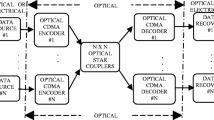Abstract
The bane of optical network is multiuser interference as a result of codewords overlap from different nodes simultaneously transmitting. Transmission scheduling is a good interference avoidance scheme which helps prevent throughput degradation at high offered load in an optical code division multiple access local area network. Interference avoidance consists of state estimation and transmission scheduling. This work examines different scheduling algorithms and parameter variations. This work investigated the performance of three scheduling algorithms (Pure Selfish Scheduling, Threshold Scheduling and Overlap Section Scheduling) against the ALOHA CDMA and our novel Hybrid—Hybridized Overlap and Threshold Scheduling—HOT algorithms using the modified padded prime codeset. The performance of the scheduling algorithms are measured in terms of its normalized network throughput, packet error rate and the average number of codewords allow into the line against the normalized offered load. The analysis shows that under this condition, the Hybridized Overlap—Threshold scheduling perform best and has throughputs as high as the 52 % with nearly zero packet error rate while the non-scheduled algorithm produce a throughput as low as 10 % and very high error rate at maximum offered load. Overall, the Threshold Scheduling and HOT algorithm are head to head and performed best in terms of normalized network throughput, however the HOT scheduling is best in terms of the packet error rate. Analysis also shows that the throughput is not affected by changes in codeset length and the mean packet size but it is affected by changes in the codeset weight. The study also analyzes the performance of the network under a bimodal packet distribution and with the Prime code codeset family. Optical Orthogonal Codeset and the Prime codeset family are used in the study under the assumption of perfect state estimation; that all nodes have the same view of the network and the transmission lines and the distance between the nodes and the central star coupler is assumed to be zero. A novel hybrid Scheduling Algorithm, the HOT Scheduling which proved better than traditional Scheduling Algorithms is peddled here.













Similar content being viewed by others

Explore related subjects
Discover the latest articles, news and stories from top researchers in related subjects.References
Chung, F. R. K., Salehi, J. A., & Wei, V. K. (1989). Optical orthogonal codes: Design, analysis and applications. IEEE Transaction on Information Theory, 35(3), 595–604.
Dono, N. R., Green, P. E., & Ramaswami, R. (1990). A wavelength division multiple access network for computer communication. IEEE Journal on Selected Area in Communications, 8(6), 983–994.
Han, S. (2002). Optical CDMA with optical orthogonal code. Electrical and computer engineering. Austin: University of Texas.
Hsu, C., & Li, V. O. K. (1997). Performance analysis of slotted fiber-optic code division multiple access (CDMA) packet networks. IEEE Transactions on Communications, 45(7), 819–828.
Kamath, P., Touch, J. D., & Bannister, J. A. (2003). Algorithms for interference sensing in optical CDMA networks, ISI Technical Report ISI-TR-2003-583.
Kamath, P., Touch, J. D., & Bannister, J. A. (2004). The need for media access control in optical CDMA networks. IEEE Infocom, 4, 2208–2219.
Kamath, P., Touch, J.D., & Bannister, J.A. (2006). Interference avoidance for optical CDMA networks. Part 2: State estimation.
Kamath, P., Touch, J.D., & Bannister, J.A. (2006). Algorithms for transmission scheduling in optical CDMA networks. In ISI-TR-2006-617 (pp. 1–14).
Karbassian, M. M., & Ghafouri-Shiraz, H. (2007). Fresh prime codes evaluation for synchronous PPM and OPPM signaling for optical CDMA networks. Journal of Lightwave Technology, 25(6), 1422–1430.
Keiser, G. (2000). Optical fiber communications. Electrical engineering series (3rd ed.). Singapore: McGraw Hill International Editions.
Keshavarzian, A., & Salehi, J. A. (2002). Optical orthogonal code acquisition in fiber-optic CDMA systems via the simple-search method. IEEE Transactions on Communications, 50(3), 473–483.
Kramer, G., & Pesavento, G. (2002). Ethernet passive optical network (EPON): Building a next-generation optical access network. IEEE Communications Magazine, 40, 66–73.
Lee, W. C. Y. (1991). Overview of cellular CDMA. IEEE Transactions on Vehicular Technology, 40(2), 292–302.
Leon-Garcia, A., & Widjaja, I. (2004). Communication Networks: Fundamental Concepts and Key Architectures (2nd ed.). Singapore: McGraw Hill.
Ojanpera, T., & Prasad, R. (1998). An overview of CDMA evolution towards wideband CDMA. IEEE Communications Surveys, 1(1), 1–28.
Ramaswami, R., & Sivarajan, K. N. (2002). Optical networks: A practical perspective (2nd ed.). Missouri: USA Morgan Kaufmann Publishers.
Stok, A., & Sargent, E. H. (2002). System performance comparison of optical CDMA and WDMA in a broadcast local area network. IEEE Communication Letters, 6(9), 409–411.
Stok, A., & Sargent, E. H. (2003). Comparison of utilization in optical CDMA and WDMA broadcast local area networks with physical noise. IEEE, 2003, 1335–1339.
Viterbi, A. J. (1995). CDMA principles of spread spectrum communication. Boston: Addison Wesley Longman Publishing Co., Inc.
Yang, S. C. (1998). CDMA RF system engineering. Norwood: Artech House.
Zhang, C., Qiu, K., & Xu, B. (2006). Investigation on performance of passive optical network based on OCDMA. IEEE, 3, 1851–1855.
Author information
Authors and Affiliations
Corresponding author
Rights and permissions
About this article
Cite this article
Ogunwolu, ‘., Ibidapo-Obe, O. & Oyebamiji, J.D. Transmission scheduling in optical CDMA networks using hybridized overlap and threshold (HOT) scheduling algorithm. Telecommun Syst 62, 387–401 (2016). https://doi.org/10.1007/s11235-015-0082-x
Published:
Issue Date:
DOI: https://doi.org/10.1007/s11235-015-0082-x



